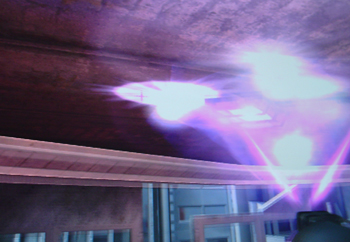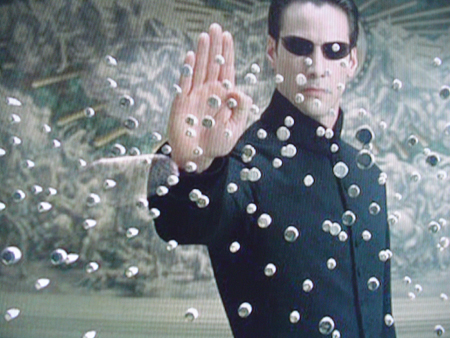A Guide to Choosing the Right 19" LCD Monitor - 7 Models Reviewed
by Kristopher Kubicki on November 30, 2004 12:04 AM EST- Posted in
- Displays
Application Analysis
The core of our LCD benchmarking comes from real application analysis. We play with a lot of monitors and it gets easier for us each time to pick out problems with an LCD just by using the right application. Here are a few quick looks at some demanding full screen applications. We already ran ColorVision's OptiCal software, so all of our monitors are calibrated and adjusted to the same curves.High Definition Video - We cheated a little bit on this portion of the analysis and handicapped all the monitors. None of these LCDs can display a true HD signal correctly without compressing pixels or cropping the image. Nevertheless, we set out to play a WMV9 1080i signal on our monitors with the interest in looking for color differences. Since our monitors have all been precalibrated, we expect the same image on each screen. Unfortunately, no amount of calibration can fix some things; we still noticed "off" reds on most of the monitors (including the Samsung 193P, the Sony, the Planar and the Dell). The BenQ, NuTech and ViewSonic occasionally managed to wash out blues a little too easily, and when looking in the right places, we could easily spot some of the differences between the 6-bit BenQ image.
The Matrix Reload, The Matrix - We use the Matrix series to test full motion video on our LCDs. Since the Matrix isn't the best movie to test color reproduction, we typically only look for motion blur or other imperfections. As expected, we noticed no fatal flaws in any of the LCDs. Although, while running some of them side by side, it became readily apparent that some monitors put a slight hint of color on the application - noticeably, the NuTech and ViewSonic monitors had a slight bluish tint.
WarHammer 40K, Dawn of War - When looking for a monitor's response time, we generally only consult first-person shooters for reference. However, those of you who have played a fast-paced game of Warcraft III or NeverWinter Nights will know that scrolling around for hours puts a severe tax on the monitor. Although we didn't notice any profound difference on the 16ms BenQ monitor, we could tell that the Sony and Planar had occasional difficulty in poorly lit areas of the game. For example, when scrolling around the last level of DOW where the majority of the level is gray ash and black soot, we would see the edge of the menu bar and status icons bleed into the ground.
Looking closer, we noticed some small differences with heavy weapons fire while scrolling on the BenQ FP931 and Samsung 193P. With enough patience, we can actually count the tracers shot over long distances, but when viewing the same scene on the Planar PE191M, the same task seems almost impossible. Attempting to do the same on the ViewSonic LCD proves futile sometimes, but not others.
Max Payne 2 - The extreme light and dark transitions in Max Payne still provide us with the sufficient criteria to benchmark transient response time; specifically, we can focus on the light and dark extremes. However, in all of the demos that we ran, we noticed virtually no difference from one monitor to another. The Samsung 193P looked a little more vibrant than its competitors, but the NuTech and ViewSonic models were displaying particularly brighter lights while maintaining the same dark hues as the SyncMaster 193P. Revisiting Max Payne with the Dell 2001FP was a little bit of a surprise. Even with the brightness set to its maximum, we were a little surprised at how much brighter the 19" LCDs were running.
Halo, Unreal Tournament 2004 - Halo and UT2K4 have very similar results, but now, we are looking for fast motion and color correctness at the same time. Again, we noticed a slightly blue tint to the BenQ monitor even after it was corrected with OptiCal. All of the monitors had a tendency to wash out, particularly in bright areas, and part of that is because we are running all of our monitors at the highest brightness levels. Specifically, the BenQ and Samsung 910V would wash out especially in bright explosions (a well-placed Redeemer usually did the trick). On occasion, the Sony SDM-934 and the Planar PE191M would blur in heavy laser battles (4 or 5 shock rifle shots firing across the screen would usually leave a small trail).

ViewSonic Q190MB
Click to Enlarge.














97 Comments
View All Comments
psoucaco13 - Wednesday, December 1, 2004 - link
I do not understand why the Samsung 910V was tested and not the 910T which costs $10-$30 more but has DVI.benk - Wednesday, December 1, 2004 - link
speedi,I think people make a big deal out of "ooh, you lose information." How many people are actually cramming all 1,920,000 pixels with useful information? I'm not. If you are, ignore the rest of this post. Seriously, I don't see the big deal...on a 17" CRT, I think 1600 x 1200 makes fonts too small unless you bump up the font size/dpi etc...I ran my trinitron at 1024x768 and I still used large fonts. The thing that clinched the wide-screen purchase for me was that I've been thinking about buying an LCD for a while now, and, while playing CS:S I realized "Hey, I don't look at the top or bottom inch of screen because they're out of my field of view, however I look all the way across the screen." I think people's eyes are simply set up to process further across than they are up and down. Whether that difference is 16:9, 16x10, whatever, I don't think is relevant. Additionally, the 2005 has slightly better specs wrt response time, contrast, and I think brightness, for the exact same price as the 2001. I think the additional width is slightly more useful for me than the decreased pixel count, especially as it allows me to put two web pages up next to each other at a readable size, without any overlap or scrolling. I guess the 2001 would let you do about the same, but I like that extra inch. I would guess anyone who would be happy with the 2001 will be happy with the 2005, and vice versa. I don't think either is a bad monitor, especially at the prices they are available at after rebates etc. Hope my overly verbose reply is helpful to some of you thinking about one or the other.
Gatak - Wednesday, December 1, 2004 - link
I want to clarify something. 24 million colours does not mean much. I read the article said it is enough to show 98% of the colours we can se. But we can not make that conclusion so easilly. We need other critical information such as dynamic range. It does not make a good monitor if it can display 24 million colours but not enough green, or deep enough blues for good sky/water and so on. Compare the monitors colour profile/characteristics against the CIE LAB model, which is a device independant model that encompasses all of the visual spectrum.Gatak - Wednesday, December 1, 2004 - link
As #61 said. The aspect ratio is wrong. The 5:4 LCD's require a 5:4 signal, like 1280x1024. The pixel ratio remains 1:1.It is rather for most CRTs that the aspect ratio is wrong if you run 1280x1024. I can't for in my life see why the recommended resolution for almost all 19" CRTs is 1280x1024, when it should be 1280x960.
Also, the bit depth guide has flaws. It does not take into account that a LCD is almost linear in its gamma curve, while a CRT not. A CRT has a gamma response of 2.5. This means that it has higher resolution for low/dark levels than for bright. It can be as high as 14bits in dark areas, but less than 7 in bright. The Gamma function "shifts" bits from bright to dark areas.
But because the LCD is more a linear device, it will have the same resolution over all levels. It will have to convert the gamma encoded video signal to a linear one. This will make you loose A LOT of resolution.
A LCD will have to have at least 14 bits to be able to show all of the colours of a 8 bit gamma 2.5 encoded signal. More modern video cards even have 10 bits of resolution for the video signal.
Also, something missing is colour gammut. It is how much or many colours from the real world it can display. sRGB has a very narrow gammut, whereas AdobeRGB is much larger (can show more of the colours we can see). If you want to perform any serious graphics work (photography, for example) you need a display that can do at least AdobeRGB or better.
Compare the various colour profiles at http://www.iccview.de . You can even upload the profile for your own device (camera, printer, monitor, scanner, etc) to see how large it is.
Another nitpick. I believe the VMW9 HD clip you played was 1080p not 1080i. Microsoft does not have any WMV9 HD clips that are interlaced ;).
ElFenix - Wednesday, December 1, 2004 - link
"19" and higher LCDs are the current sweet spot for LCD substrates. Recall that 19" LCDs have roughly the same viewing area as 21" CRT monitors"which is completely worthless because 21" CRTs easily do 1600x1200, while no 19" lcd does any better than 1280x1024. you get ~50% more desktop area from 1600x1200 than 1280x1024.
really, when 15" 1600x1200 and 17" 1900x1200 notebook screens are flying out the door, the lack of desktop lcds that do 1600x1200 and higher is disturbing. if there isn't any demand for it, what explains the notebook lcd sales? the claim just doesn't make any sense.
GOSHARKS - Wednesday, December 1, 2004 - link
well actually it isnt exactly 15"x12", but you get the idea.GOSHARKS - Wednesday, December 1, 2004 - link
"That is, a 19" LCD should have an aspect ratio of 1600x1200, 1280x960, or some derivative thereof. Most 19" and 17" LCDs have an aspect ratio of 5:4 (1280x1024). This is OK, but you're looking at a 5:4 signal crammed in a 4:3 box."uh no. 17, 18, and 19" lcds with 1280x1024 resolution are physically 5:4. my samsung 192n's display area measues 15" wide, 12" tall - making a perfect 5:4 ratio.
i am very suprised to see such an oversight coming from anandtech. in fact, the entire aspect ratio part of the article is pretty useless once this point is corrected.
KristopherKubicki - Wednesday, December 1, 2004 - link
drinkmorejava: Ghosting has to do with visual interference on the signal. Motion blur is what you refer to, and that was not rated quanitively.Kristopher
WileCoyote - Tuesday, November 30, 2004 - link
I work on computers all day long... there is no logical reason why you would want a CRT instead of a nice LCD unless you can't afford it. Monitors like the 2001FP put CRTs to shame.speedi - Tuesday, November 30, 2004 - link
benk, how is the 2005FPW? I notice that you lose a lot of pixels in the aspect ratio, but other than that... do you have an opinion? I just ordered a Dell 2001FPS for $599 and want to make sure I didn't overlook the FPW when I "should" have gotten it instead. I love 1600x1200... but I am used to 1600x1200 on a Viewsonic P810, which is razor sharp. Does anyone happen to know how this will compare? I took the 2001FPS based on the former AnandTech review.- Speedi